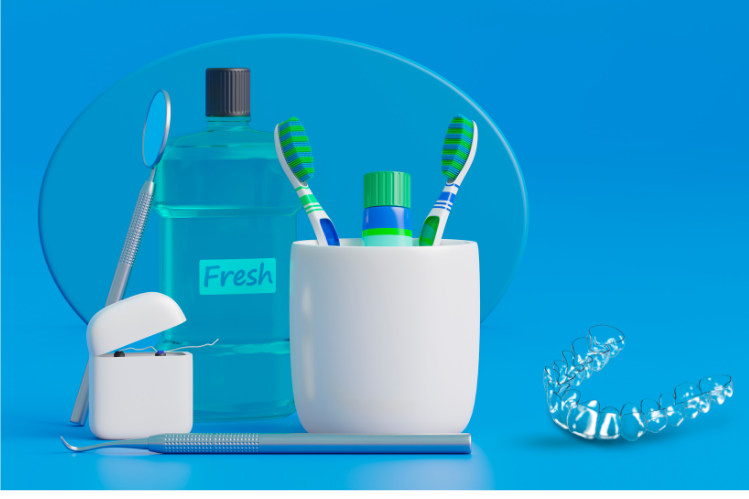
Do your retainers give off an unpleasant odor when you take them out? If so, you’re not alone. Many people experience this and often find themselves asking: “Why does my retainer smell bad?” or “Why does my retainer smell when I take it out?”
Retainers are a crucial part of orthodontic treatment. They help keep your teeth in their new, aligned positions after braces or clear aligners. However, because retainers spend so many hours inside your mouth, they are constantly exposed to saliva, bacteria, and small food particles. Without proper cleaning, these conditions quickly lead to odors. What starts as a faint smell can soon intensify into something much stronger, and even embarrassing, if left unaddressed.
The good news? With the right retainer cleaning methods and daily habits, you can keep your retainer fresh and odor-free. This detailed guide will explain exactly why retainers smell, the health risks of ignoring them, and the best ways to clean and prevent retainer odor.
Why Does My Retainer Smell?

The biggest reason behind retainer odor is bacterial buildup. Your retainer is always in contact with saliva and often traps tiny food particles, which makes it the perfect breeding ground for bacteria. Let’s break down the major causes in detail:
Bacterial Growth
Your mouth naturally contains millions of bacteria. While most are harmless, some produce sulfur compounds, the same ones responsible for morning breath. If your retainer isn’t cleaned regularly, bacteria multiply on its surface, causing a foul odor that worsens over time.
Plaque and Tartar Deposits
Just like teeth, retainers can accumulate plaque. If plaque isn’t removed daily, it hardens into tartar. Once tartar forms on your retainer, it clings tightly to the surface, traps bacteria, and gives off a bad smell. It also makes cleaning much harder.
Food Particles
Small food particles can easily get trapped between your teeth and the retainer. If you reinsert your retainer without rinsing after a meal, those tiny leftovers begin to decay, which quickly leads to bad smells.
Saliva Chemistry and Dry Mouth
Saliva is your body’s natural mouth cleanser, washing away bacteria and food debris. But if you suffer from dry mouth, due to dehydration, certain medications, or mouth breathing, bacteria grow faster. This not only causes bad breath but also intensifies retainer odor.
Improper Storage
How you store your retainer when it’s not in your mouth matters. Storing it while wet in a closed case creates a warm, humid environment where bacteria thrive. The next time you wear it, the smell will be stronger.
Eating and Drinking with Retainers On
Many orthodontists strongly advise against eating with your retainer in. Not only can chewing damage the appliance, but it also allows food and sugars to stick directly to its surface. Sugary drinks such as soda, juice, or even coffee can cling to your retainer, causing stains and bad smells.
Health Risks of Smelly Retainers
A retainer that smells bad isn’t just unpleasant; it may also signal more serious oral health risks. Ignoring retainer hygiene can lead to:
- Gum Disease: Bacteria from dirty retainers irritate your gums, causing inflammation, bleeding, and gingivitis.
- Tooth Decay: Plaque from your retainer can transfer back to your teeth, increasing the risk of cavities.
- Oral Infections: Unclean retainers can harbor harmful bacteria and fungi, which may lead to oral infections, especially in people with weaker immune systems.
- Digestive Issues: Constantly swallowing bacteria from a dirty retainer may upset your stomach or digestive tract.
- Retainer Damage: Tartar buildup and improper cleaning shorten the lifespan of your retainer, meaning you’ll need expensive replacements sooner.
Keeping your retainer fresh is about much more than odor; it’s essential for protecting your long-term oral health.
How to Get Rid of Retainer Smell?
If your retainer smells, don’t panic. There are reliable methods to eliminate odors and restore freshness:
Brush Your Retainer Daily
- Use a soft-bristled toothbrush (separate from the one you use for your teeth).
- Apply mild soap or non-abrasive toothpaste.
- Gently brush all surfaces to remove bacteria and plaque.
Avoid whitening toothpaste or harsh scrubbing; these can scratch your retainer, creating spaces where bacteria hide.
Use Retainer Cleaning Tablets
Available in most pharmacies, these effervescent tablets dissolve in water to create a fizzing solution that removes bacteria, odors, and stains. Soak your retainer for 10–15 minutes a few times per week for best results.
Rinse after Every Meal
Before putting your retainer back in, rinse it under lukewarm water. This simple step helps prevent food particles from sticking and keeps bacteria from multiplying.
Try Natural Cleaning Solutions
- White Vinegar: Mix equal parts vinegar and water, soak your retainer for 15–20 minutes, then rinse well.
- Baking Soda: Dissolve 1 teaspoon of baking soda in a cup of water for a natural deodorizer.
- Hydrogen Peroxide (Diluted): Works for occasional deep cleaning but should not be used daily, as it may weaken the retainer.
Professional Dental Cleaning
During your regular dental visits, ask your dentist to deep-clean your retainer using an ultrasonic cleaning machine. This helps remove tartar that’s difficult to eliminate at home.
Avoid Hot Water and Harsh Chemicals
Never clean your retainer with boiling water, bleach, or alcohol-based mouthwash. These can warp or damage the material, making the retainer unwearable.
Clean the Retainer Case
Even if you clean your retainer well, a dirty case can reintroduce bacteria. Wash your case daily with soap and water, then let it air dry before storing your retainer.
Tools to Clean Your Retainer Fresh
Having the right tools makes retainer care much easier:
- Effervescent Cleaning Tablets: Brands like Retainer Brite or Steraligner work well for quick, effective freshness.
- Ultrasonic Cleaners: Small home devices that use sound waves to remove plaque and bacteria, providing professional-level cleaning.
- Dedicated Soft-Bristle Toothbrush: Keep one just for your retainer to avoid cross-contamination.
- Ventilated Travel Cases: Special cases with airflow reduce bacteria growth compared to sealed plastic ones.
- DIY Natural Cleaners: Baking soda and vinegar solutions are affordable and safe options.
How to Keep Retainers from Smelling?
Preventing odor is always easier than trying to remove it later. Follow these habits daily:
- Stick to a Daily Cleaning Routine: Brush and rinse your retainer every day.
- Never Eat with Retainers In: This is the fastest way food gets trapped and causes odors.
- Store Properly: Always use a ventilated case. Avoid wrapping retainers in tissues or napkins; bacteria thrive in damp environments.
- Stay Hydrated: Drinking water keeps your mouth moist and helps wash away bacteria.
- Avoid Sugary Drinks with Retainers: Sugar fuels bacterial growth. Stick to water while wearing them.
- Replace Retainers When Needed: Over time, scratches and wear make retainers harder to clean. If yours continues to smell despite good care, it may be time for a replacement.
Check out our detailed guide on Smelly retainers: Causes, solutions, and care tips for more information on this.
Introducing ALIGNERCO Cleaning Solution for Retainers

If your retainer smells bad or looks cloudy, you’re not alone. Retainers and clear aligners are prone to buildup from plaque, saliva, and food particles. Over time, they can develop odors, discoloration, and even stains, making you wonder if you need to replace them sooner than expected.
That’s where an aligner cleaner + whitener comes in handy.
Final Takeaways: The Secret to Odor-Free Retainers
A smelly retainer is a common issue caused by bacteria, plaque, and improper cleaning, but the solution is simple: consistent care and the right products. By brushing daily, rinsing after meals, and storing your retainer properly, you can prevent odors and protect your oral health. For an all-in-one solution, try the ALIGNERCO Aligner Cleaner + Whitener. It not only eliminates odor-causing bacteria but also keeps your retainer crystal clear while gently whitening your smile. Stay confident, fresh, and worry-free with ALIGNERCO, the easiest way to keep your retainer clean and your smile bright.
FAQs
1. How to stop retainers from smelling bad?
Brush your retainer daily, soak it weekly in cleaning solution, rinse after meals, and store it in a ventilated case.
2. Why does my retainer smell when I take it out?
The odor usually comes from bacteria and plaque buildup. Saliva dries on the retainer, and when exposed to air, it releases a stronger smell.
3. Can I use mouthwash to clean my retainer?
Not recommended. Many mouthwashes contain alcohol, which can damage the plastic retainer. Use mild soap, cleaning tablets, or baking soda instead.
4. How often should I clean my retainer?
Every day. A quick daily cleaning plus weekly deep cleaning ensures freshness.
5. How long should retainers last with proper care?
Depending on the type, most last 1–5 years. Proper cleaning and care extend their lifespan.
Citations:
Chadwick, R. G., & Manton, S. L. (1999). Surface texture and biofilm accumulation on commonly used orthodontic retainer materials. Dental Materials, 15(5), 353–362. https://doi.org/10.1016/S0109-5641(99)00062-4
Levrini, L., Novara, F., Margherini, S., Tenconi, C., & Raspanti, M. (2016). Scanning electron microscopy analysis of the biofilm on the surface of removable orthodontic retainers. Dental Research Journal, 13(4), 331–337. https://doi.org/10.4103/1735-3327.187883
Shpack, N., Greenstein, R. B., Gazit, D., Sarig, R., & Vardimon, A. D. (2004). Efficacy of three hygienic protocols in reducing biofilm adherence to removable thermoplastic appliances. Angle Orthodontist, 74(4), 414–418. https://doi.org/10.1043/0003-3219(2004)074<0414:EOTHPI>2.0.CO;2
Türköz, Ç., & Bayrak, R. (2012). Oral colonization and appliance-related changes in microbiota during orthodontic treatment. Journal of Applied Oral Science, 20(4), 476–481. https://doi.org/10.1590/S1678-77572012000400007





